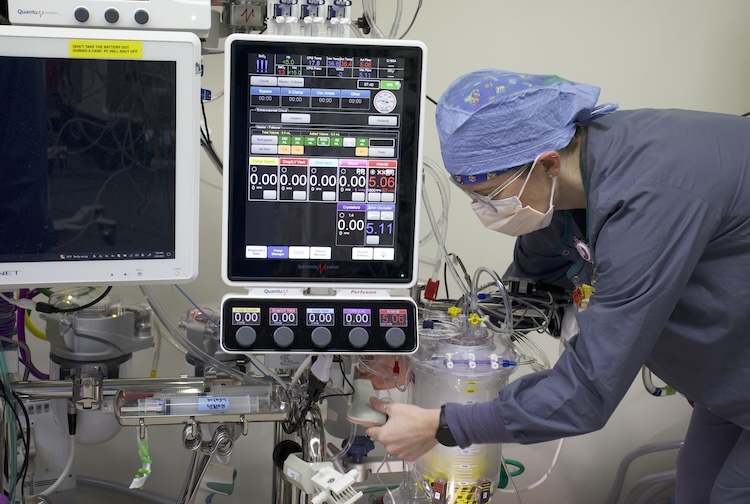Calming a racing heart: Atrial fibrillation and treatment
November 04, 2020
 Atrial fibrillation, or AFib, is a type of irregular heartbeat that can greatly increase your risk of stroke. The condition is relatively common in adults over the age of 40, with about one in four at risk.
Atrial fibrillation, or AFib, is a type of irregular heartbeat that can greatly increase your risk of stroke. The condition is relatively common in adults over the age of 40, with about one in four at risk.
To help you understand AFib and how we treat it, we turn to Dr. Kenneth Ellenbogen, chair of cardiology at VCU Health.
Understanding atrial fibrillation
“Normally, most people are completely unaware of their heartbeat, and for those people, that's wonderful,” Ellenbogen says. “For patients who have atrial fibrillation, they have an abnormality of the electrical system of their heart, primarily located in the atrial chambers — the upper chambers of the heart.”
A series of electrical events, originating in the sinus node, fan out to the right and left atria and down to the ventricles (the lower chambers of the heart). Atrial fibrillation, as the name suggests, is an abnormal heart rhythm in the heart's upper chambers, the atria.
“Not only is that atrial rate amazingly fast, but it's completely disorganized,” Ellenbogen says. “In normal rhythm, there's a uniform sequence of activation of the heart and it goes the same way for every beat. In AFib, the electrical impulses come from different directions every second, coming from one part of the atrium, then another part of the atrium.”
AFib may occur only occasionally (paroxysmal) or may be constant (chronic). “We are working hard to try to understand why some patients have atrial fibrillation and others do not,” Ellenbogen adds. Sleep apnea, obesity and hypertension are among the conditions that increase your risk of AFib, he notes. AFib, however, is not necessarily related to coronary artery disease or heart attacks.
AFib and stroke
When your heart is in AFib, the abnormal movements can lead to blood pooling. “Blood tends to pool in a structure called the atrial appendage, which has little ridges and furrows in it,” Ellenbogen explains. “When the blood pools there, you can have a clot. A clot can be about the size of the tip of a ballpoint pen, and that clot can shoot out the heart up the aorta into the brain.”
The more frequently AFib occurs, the greater your risk of stroke. “Patients who are in a permanent AFib or in AFib for long periods of time — we absolutely worry about them developing strokes more than somebody who has AFib for 30 seconds.” People with AFib have a five-time greater risk of developing stroke than those without AFib.
AFib cases going up
“We're not exactly sure what's going on. Some people believe that it's an epidemic of AFib, and those people believe the epidemic is primarily a reflection of the aging population,” Ellenbogen notes. “Others believe that this epidemic is related to other dangerous conditions the patient may have at the same time. Let's face it, a lot more Americans are obese now than they were 50 years ago.”
In addition, the changing face of technology has made detection more widely available. “Now, people buy these mobile apps, people buy watches, and they can figure out that they have AFib when before, we may not have caught it unless they happened to be in the doctor's office when the condition occurred.”
Treating atrial fibrillation
“We have a full range of tools and techniques to treat AFib,” Ellenbogen continues. At VCU Health Pauley Heart Center, where doctors perform catheter-based ablations to remove areas of the heart causing AFib, Dr. Ellenbogen is proud to say they have the procedure down to a science. “When I started 22 years ago, if we did one of these procedures it took us eight hours,” he recalls. “I'd say now we can do a procedure in anywhere from two to three hours.”
Ablation may be performed with an open-heart operation or a minimally invasive approach.
“I often send patients home the same day,” Ellenbogen notes. “We tell them, 'Hey, you're going home.' We're done at 11 o'clock, they're home by four o'clock, and the next day they're getting their mail, they're cooking their lunch or dinner. And five days later, they're running on a treadmill in the gym. It's a very quick recovery. It's an invasive procedure, but the recovery is awfully quick.”
Medications can treat AFib, but there hasn't been much progress in drug development, Ellenbogen states. Some “interesting” new drugs are being studied, though. “Hopefully in the next five or 10 years we'll have different classes of drugs which work on the different mechanisms that cause AFib,” he says.
To prevent stroke, patients often take blood thinners, but this carries an increased risk of bleeding. For those who can't take that risk, a surgical solution is available. “We have what we call left atrial appendage occlusion devices — a device that can be put in, in the catheterization laboratory, or a permanent device that closes off the left atrial appendage. So, a patient does not have a stroke and does not need to be on a blood thinner.”
Experience matters
“We have a total of six electrophysiologists, including myself,” Ellenbogen summarizes. “Five plus myself all interested in helping patients who have atrial fibrillation, and all interested in working with patients to find what works best for that patient.” Ellenbogen alone has over 22 years' experience treating AFib.
To make an appointment, visit our scheduling and referrals page or call (800) 762-6161 or (804) 628-4327 on weekdays from 8 a.m. to 5 p.m. For virtual visit scheduling, call (804) 628-4327 or visit our telehealth page. Learn more at vcuhealth.org/heart.
Listen to our podcast
Listen to an in-depth conversation on this topic with Dr. Ellenbogen on this podcast. For information on how VCU Health treats atrial fibrillation, visit the VCU Health Pauley Heart Center.




